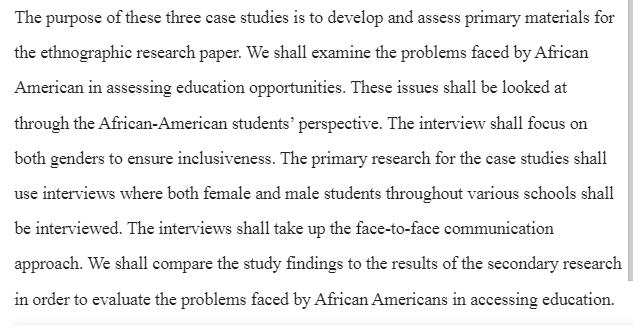Ethnography Project Case Studies-Ethnography Project Case Studies
Grade value: 20% of grade for the course
Evaluation: The project will be graded for professionalism, clear focus, comprehensiveness, careful language, adherence to APA citation rules, and understanding of the conventions of research and case studies as discussed in class.
Topic: The purpose of the case studies is to develop and assess primary material for the ethnographic research paper, focused on a carefully defined ethnic or cultural group.
Step 1: Prepare release forms. Prepare your release forms using the template on our Moodle class page. Have your interview subjects sign your release forms at the beginning of their interviews. If you conduct interviews electronically, print out e-mails from your subjects acknowledging that they have read the form and agreed to it. Remember to turn in the signed release forms in class.
Step 2: Conduct interviews. The project requires interviews with three individuals from the ethnic or cultural group being studied. Record your interviews, using either audio or video (either could be incorporated into your upcoming classroom presentation). Although you should have a clear idea of the main issues you want to cover in your interviews, try to maintain a spontaneous conversation—ideally, you should learn things from your participants that you had not expected beforehand. Online interviews are acceptable, but face-to-face interviews generally produce more useful results.
Step 3: Write up the case studies. The project requires interviews with three individuals from the socio-cultural group being studied. Write individual case studies on each of your interview subjects. In addition to evaluating specific findings from your interviews, each case study should compare your interview subject with the findings of your bibliography sources. Each case study should include a few quotations from your interviews. Your bibliography sources, on the other hand, should be cited using paraphrase or summary (APA recommends avoiding direct quotations from published sources). Remember that direct quotations, paraphrase, and summary all require in-text citations (author, date). Each case study should be at least 300-600 words long.
Style: To construct an effective, professional-sounding case study, you’ll want to strive for a balance between representing your interview material in an interesting way and meaningfully relating that material to the published research on your topic. You should incorporate brief quotations from your interviews, along with your own overview of what the subject said. (See the model for in-text citation of interviews below.) In discussing the published sources, use paraphrase and summary instead of quotation, followed by parenthetical citations in APA Style. Following the conventions of APA Style, do not use first person in your paper. You may refer to yourself in third person as the interviewer, the researcher, the author, etc., or better yet, simply phrase your sentences to avoid referring to yourself at all. Unlike MLA style, APA does not discourage use of the passive voice. For example:
Active voice in first person: “I conducted the interviews in February, 2016.”
Passive voice, avoiding first person: “The interviews were conducted in February, 2016.”
Answer Preview-Ethnography Project Case Studies

